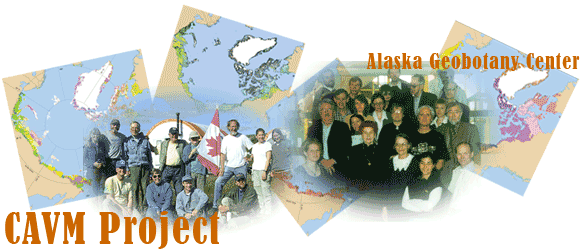| Arctic bioclimate zone |
|---|
| The region of this map; the bioclimate zone north of the climatic limit of trees that is characterized by an Arctic climate, Arctic flora, and tundra vegetation. It includes all the arctic tundra regions with an Arctic climate and Arctic flora, but it excludes tundra regions that have a boreal flora such as the boreal oceanic areas of Iceland and the Aleutian Islands, and alpine tundra regions south of the latitudinal treeline. |
| Bioclimate zone |
|---|
| A region of the Earth’s surface with characteristic climate, flora, and vegetation. Bioclimate subzones are subdivisions based on a combination of floristic composition, dominant plant community structure (physiognomy), and the suite of plant communities in common habitats (See Table 1, reverse side). The bioclimate subzones used here are adopted with modification from the phytogeographic subzones of Yurtsev (1994) and the bioclimate zones of the Panarctic Flora Initiative (Elvebakk et al. 1999). |
| Carbonate |
|---|
| Refers to limestone or dolomite bedrock. These bedrock types result in soils with high calcium content, high pH, and plant communities adapted to such conditions. Noncarbonate refers to sandstone, granite, or other rock types with few carbonates. |
| Cryptogam |
|---|
| A plant that reproduces sexually without forming seeds. This group includes many common tundra ground plants, such as lichens, symbiotic associations of algae and fungi, and mosses, members of the class Musci. |
| Forb |
|---|
| A broadleaf herbaceous (nonwoody) flowering plant. Does not include graminoids. |
| Graminoid |
|---|
| A grass-like herbaceous plant with leaves mostly very narrow or linear in outline. This group includes grasses, members of the plant family Poaeceae; rushes, members of the plant family Juncaceae; and sedges, members of the plant family Cyperaceae. Sedges are further divided into tussock sedges, those with a caespitose or bunch-forming habit (refers here mainly to Eriophorum vaginatum), and nontussock sedges, those with other growth forms, usually growing from rhizomes, stolons, or singly. |
| Herb |
|---|
| A flowering plant with no significant woody tissue above ground. Herbaceous plants include forbs and graminoids. |
| Nunatak |
|---|
| A nonglaciated area surrounded by glaciers, often a mountain peak taller than the surrounding glaciers. |
| Physiognomy |
|---|
| The general outward appearance of a plant community, determined by the life forms of the dominant species, e.g., grassland, forest, tundra. |
| Plant functional type |
|---|
| A category of plants based on factors such as growth form, size and taxonomic status. The tundra plant functional types used in the map-unit names include graminoids, forbs, shrubs of various stature, and cryptogams (mosses and lichens). (See these categories for further explanation.) |
| Riparian |
|---|
| An intrazonal habitat pertaining to streamside environments. |
| Shrub |
|---|
| A woody perennial plant differing from a tree by its lower stature and by producing several basal stems instead of a single trunk. This group includes: tall shrub, greater than 2 m tall (e.g., Alnus crispus, Salix alaxensis); low shrub, between 0.4 and 2 m tall (e.g., Betula glandulosa, Salix glauca); and dwarf shrub, less than 0.4 m tall. Dwarf shrubs are further divided into erect dwarf shrub, less than 0.4 m tall with erect stems (e.g., Vaccinium uliginosum, Ledum decumbens, Betula nana); hemiprostrate dwarf shrub, very short, generally less than 0.15 m tall, with a semi-erect or trailing stem (refers here mainly to Cassiope tetragona); prostrate dwarf shrub, lying flat on the ground (e.g., Dryas, Arctous rubra, Salix arctica). |
| Tundra |
|---|
| A physiognomic descriptor of low-growing vegetation beyond the cold limit of tree growth, both at high elevation (alpine tundra) and at high latitude (arctic tundra). Tundra vegetation types are composed of herbaceous plants, shrubs, mosses, and lichens. |
| Wetland |
|---|
| An intrazonal habitat where soil water saturation is the dominant factor determining the nature of soil development and vegetation. |
| Zonal vegetation |
|---|
| Vegetation within a specified bioclimate zone that ultimately develops on sites with moderate slope, soil, snow, site moisture, and disturbance. |
|
|---|

